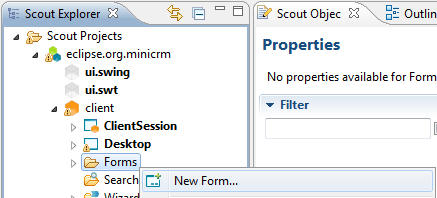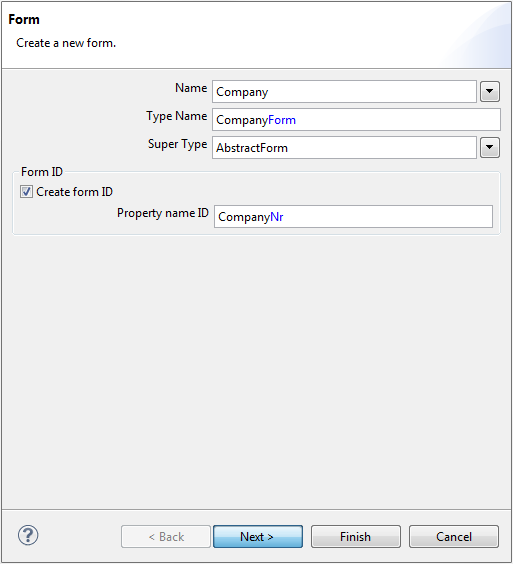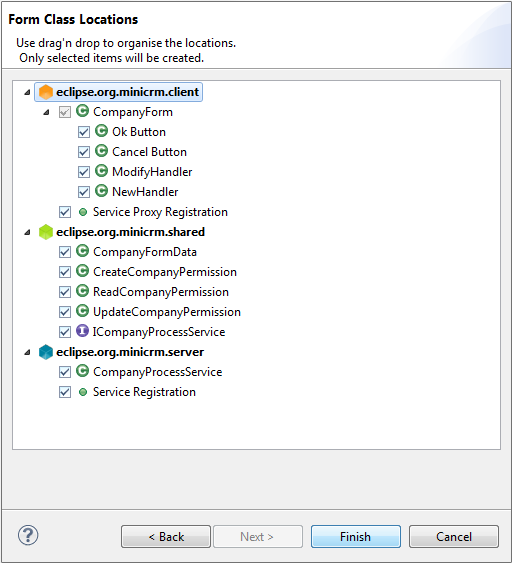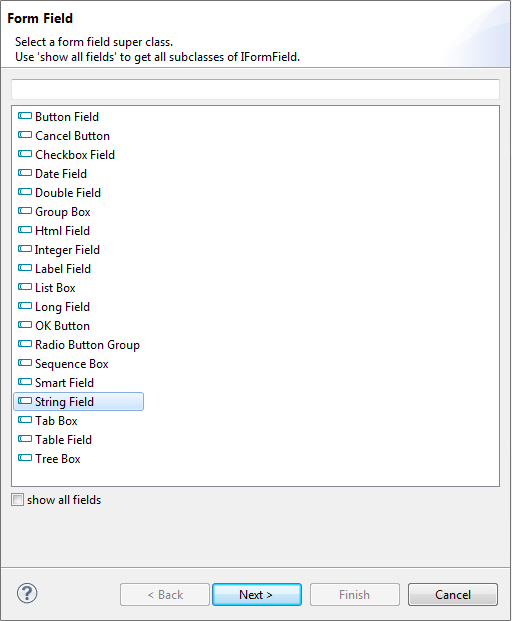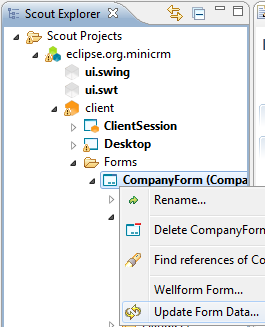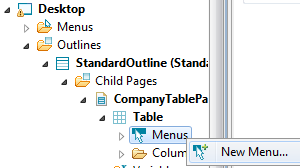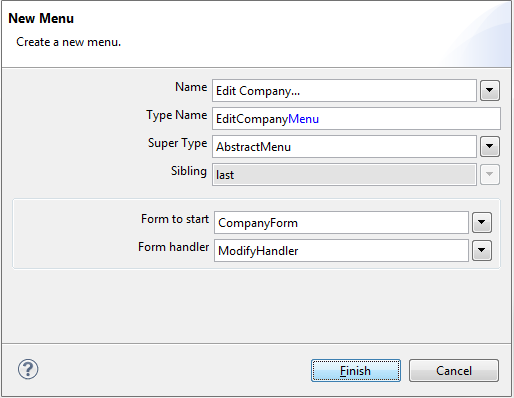Notice: This Wiki is now read only and edits are no longer possible. Please see: https://gitlab.eclipse.org/eclipsefdn/helpdesk/-/wikis/Wiki-shutdown-plan for the plan.
Difference between revisions of "Scout/Tutorial/3.7/Minicrm/Add a form to edit the data"
(→Modify the form's ProcessService) |
|||
| Line 35: | Line 35: | ||
== Modify the form's ProcessService == | == Modify the form's ProcessService == | ||
| − | Go to the server node of your Scout project, open the node ''Process Service'' and expand it. Double click on the entry ''CompanyProcessService'' in order to open it. | + | Go to the server node of your Scout project, open the node '''Process Service''' and expand it. Double click on the entry '''CompanyProcessService''' in order to open it. |
| + | |||
<source lang="java"> | <source lang="java"> | ||
public class CompanyProcessService extends AbstractService implements ICompanyProcessService{ | public class CompanyProcessService extends AbstractService implements ICompanyProcessService{ | ||
| Line 72: | Line 73: | ||
} | } | ||
</source> | </source> | ||
| − | |||
| + | As you can see, the generated ''process service'' contains ''four methods''. If you check from where they are called (Ctrl+Shift+G), you will notice that the callers are two ''form handlers'': a '''NewHandler''' and a '''ModifyHandler'''. | ||
| + | These two handlers are '''inner classes''' of the ''company form''. You can see them in the Scout SDK as well: expand the ''CompanyForm'' node and you'll find the ''Handlers'' node right there. | ||
| − | + | '''Form handlers''' are used to start a form in a particular ''mode''. For instance, if you want to use your form to add a new company, you want to bring it up empty. On the other hand, if you want to use it to edit an already existing company, you want to bring it up already containing the company's values. | |
| − | + | ||
A FormHandler's methods are are executed in a specified order. With that, you can control a form's processing at different moments or with the form in different state: | A FormHandler's methods are are executed in a specified order. With that, you can control a form's processing at different moments or with the form in different state: | ||
| − | # execLoad: Loads form state | + | |
| − | # execPostLoad: After the form | + | # execLoad: Loads form state before it is made visible |
| − | # execCheckFields: Executed before execValidate but after ''AbstractForm.execCheckFields()''. Returning false cancels | + | # execPostLoad: After the form is loaded, changes to fields inside this method result in marking the form as ''changed'' and thus requiring a ''save''. |
| + | # execCheckFields: Executed before execValidate but after ''AbstractForm.execCheckFields()''. Returning false cancels processing. | ||
# execValidate: Executed after ''AbstractForm.execValidate()''. | # execValidate: Executed after ''AbstractForm.execValidate()''. | ||
| − | # execStore: After this method call, the form is in the state '' | + | # execStore: After this method call, the form is in the ''unchanged'' state with no ''save'' required. Executed before ''AbstractForm.execStored()''. |
| − | # execDiscard | + | # execDiscard |
# execFinally | # execFinally | ||
| − | Please consult the javadoc of these methods | + | Please '''consult the javadoc of these methods''' for details. |
| + | |||
| + | Here's how our ''CompanyProcessService'' methods are called: | ||
| + | {| | ||
| + | |Handler | ||
| + | |opening | ||
| + | |closing | ||
| + | |- | ||
| + | |ModifyHandler | ||
| + | |load | ||
| + | |store | ||
| + | |- | ||
| + | |NewHandler | ||
| + | |prepareCreate | ||
| + | |create | ||
| + | |} | ||
| − | Furthermore you can see | + | Furthermore you can see in the source code generated that '''Permissions are checked'''. These checks exist on both the client and on the server side. On the client side, these are simple convenience checks to prevent the user from changing fields if they cannot be saved. |
| + | We need similar checks on the server side to handle service calls from outside the client. | ||
| + | The process service could potentially be used by an interface, for example. | ||
== Load the data for the form == | == Load the data for the form == | ||
Revision as of 08:53, 13 October 2010
We need to create a form containing various fields, we need to have a process service that allows us to select, insert, and update data on the database, and we need a context menu to call the form, possibly passing along an id (the primary key) to the form if we want to edit a particular row.
Contents
Create a form
We now build a form to add and edit companies. Expand the node client of your Scout project, scroll down to the node Forms, right click on it and select New Form...
As name for the form choose Company. As you can see on the New Form Wizard a form ID called CompanyNr will automatically be created. This ID is later needed to pass the primary key of the company you want to display the data for in the form.
When you click Next, you'll see permissions and a process service will also be created for this form. We'll discuss these later.
Click Finish to create the form.
When you now expand the tree below your CompanyForm you can see a MainBox. This is the mandatory root element for every form. Inside this MainBox you can now add fields as you wish by right clicking on it and choosing New Form Field.
On the New Form Field wizard you need to choose a template for the field. First, we want to add a field for the company's name, therefore choose String Field. Click Next and enter the name of the field ("Name") and then click Finish.
Now proceed in the same way and add a field for the Short Name.
You should already have an Ok button (OK Button template) and a Cancel button (Cancel Button template). The two buttons don't need a name since they'll get appropriate names from their template.
Modify the form's ProcessService
Go to the server node of your Scout project, open the node Process Service and expand it. Double click on the entry CompanyProcessService in order to open it.
public class CompanyProcessService extends AbstractService implements ICompanyProcessService{ public CompanyFormData prepareCreate(CompanyFormData formData) throws ProcessingException{ if(!ACCESS.check(new CreateCompanyPermission())){ throw new VetoException(Texts.get("AuthorizationFailed")); } // TODO business logic here return formData; } public CompanyFormData create(CompanyFormData formData) throws ProcessingException{ if(!ACCESS.check(new CreateCompanyPermission())){ throw new VetoException(Texts.get("AuthorizationFailed")); } // TODO business logic here return formData; } public CompanyFormData load(CompanyFormData formData) throws ProcessingException{ if(!ACCESS.check(new ReadCompanyPermission())){ throw new VetoException(Texts.get("AuthorizationFailed")); } // TODO business logic here return formData; } public CompanyFormData store(CompanyFormData formData) throws ProcessingException{ if(!ACCESS.check(new UpdateCompanyPermission())){ throw new VetoException(Texts.get("AuthorizationFailed")); } // TODO business logic here return formData; } }
As you can see, the generated process service contains four methods. If you check from where they are called (Ctrl+Shift+G), you will notice that the callers are two form handlers: a NewHandler and a ModifyHandler.
These two handlers are inner classes of the company form. You can see them in the Scout SDK as well: expand the CompanyForm node and you'll find the Handlers node right there.
Form handlers are used to start a form in a particular mode. For instance, if you want to use your form to add a new company, you want to bring it up empty. On the other hand, if you want to use it to edit an already existing company, you want to bring it up already containing the company's values.
A FormHandler's methods are are executed in a specified order. With that, you can control a form's processing at different moments or with the form in different state:
- execLoad: Loads form state before it is made visible
- execPostLoad: After the form is loaded, changes to fields inside this method result in marking the form as changed and thus requiring a save.
- execCheckFields: Executed before execValidate but after AbstractForm.execCheckFields(). Returning false cancels processing.
- execValidate: Executed after AbstractForm.execValidate().
- execStore: After this method call, the form is in the unchanged state with no save required. Executed before AbstractForm.execStored().
- execDiscard
- execFinally
Please consult the javadoc of these methods for details.
Here's how our CompanyProcessService methods are called:
| Handler | opening | closing |
| ModifyHandler | load | store |
| NewHandler | prepareCreate | create |
Furthermore you can see in the source code generated that Permissions are checked. These checks exist on both the client and on the server side. On the client side, these are simple convenience checks to prevent the user from changing fields if they cannot be saved. We need similar checks on the server side to handle service calls from outside the client. The process service could potentially be used by an interface, for example.
Load the data for the form
As a first thing you may want to enable the editing of an existing company entry. Therefore go to the load method and select the data to be displayed in the form using the SQL method SQL.selectInto. In the INTO part of your SQL statement you can specify the the corresponding form data fields by typing :<name of formdata field> (as before when you added constraints to your SELECT statement). You'll notice that when you start typing : and then press CTRL-Space, there is a Content assistance which provides for the available form data fields. If you find that there is a form data field missing, maybe your FormData is not up to date. You can update a FormData anytime by calling Update Form Data by right clicking on the corresponding Form. In the where-part of your statement you have to specify the company's primary key. This is contained in a field companyNr, as this was the name of the Form ID we specified before and is now contained in the FormData object as well.
SQL.selectInto( "SELECT SHORT_NAME, "+ " NAME " + "FROM COMPANY " + "WHERE COMPANY_NR = :companyNr " + "INTO :shortname," + " :name" ,formData);
From Form to FormData to Form
Forms provide an import and export method, respectively. Therefore loading data into and storing them from a form into a form data is just a single method call. This has already been automatically added by Scout in the FormHandler methods.
@Override
public void execLoad() throws ProcessingException{
ICompanyProcessService service = SERVICES.getService(ICompanyProcessService.class);
CompanyFormData formData = new CompanyFormData();
exportFormData(formData);
formData = service.load(formData);
importFormData(formData);
setEnabledPermission(new UpdateCompanyPermission());
}Start the Form
Now the last thing to do is to actually call the form and to open it. In order to do that we need a menu on the CompanyTablePage. Go to your CompanyTablePage expand it twice, click on the node Menu, right click and choose New Menu....
Enter a name for your form, and in the field Form to start specify your CompanyForm and click finish.
Update the company with the new values
Now we need to edit the store method in the CompanyProcessService and add the sql statement for the update.
@Override
public void store(CompanyFormData formData) throws ProcessingException {
if(!ACCESS.check(new UpdateCompanyPermission())){
throw new VetoException(Texts.get("AuthorizationFailed"));
}
SQL.update(
"UPDATE COMPANY SET" +
" SHORT_NAME = :shortname, " +
" NAME = :name " +
"WHERE COMPANY_NR = :companyNr", formData);
return formData;
}Pass the primary key and reload page
If you open the generated EditCompanyMenu you see that there has been generated code inside a method execAction. This code actually opens the form. What is missing here is the forwarding of the companyNr. The companyNr is inside the table in the CompanyNrColumn in the row the user currently selected. To get that value simply rewrite the code like this:
@Override
public void execAction() throws ProcessingException {
CompanyForm form = new CompanyForm();
form.setCompanyNr(getCompanyNrColumn().getSelectedValue());
form.startModify();
form.waitFor();
if (form.isFormStored()){
reloadPage();
}
}The method startModify starts the modify handler. The waitFor interrupts the execution at this point, until the form is closed again. With isFormStored we check wether the user has closed the form by pressing the OK-Button (form values are stored) or by pressing the Cancel-Button (form values are discarded). In the first case we reload the current table the see the changes instantly.

